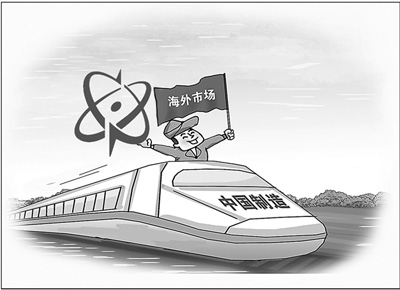

 |
| (Photo/People's Daily Overseas Edition) |
Following high-speed railway, nuclear power has become a new international calling card for China's equipment manufacturing industry.
China and Argentina have recently signed an agreement to build a pressurized water reactor (PWR) nuclear power plant in Argentina, marking the first strike for the "going global" strategy of China's independent third-generation nuclear power technology.
Experts believe that China's equipment manufacturing industry, represented by high-speed rail and nuclear power, will become a new engine for the country's economic growth shift from low-end to high-end in the future.
China's third-generation nuclear power gets first foreign order
China's domestic nuclear power technology is now mature, and the country is setting its sights on overseas markets.
The recent deal with Argentina has opened the door to overseas markets. After decades of development, China's nuclear power has accumulated prominent market acceptance and operational experience. "Going global" has become a national strategy.
According to the International Atomic Energy Agency, 60 to 70 nuclear power plants of 1 million kilowatts will be built in the world in the next 10 years - excluding China - which means that overseas nuclear power contracts will reach a market value of one trillion yuan.
Song Qinghui, an economist, remarks that the push to globalize China's nuclear technology and the development of nuclear power projects are of great significance for improving the country's high-end manufacturing industry and guiding the development of relevant industries.
High-speed rail and nuclear power jointly create a new calling card
China's railway industry, with high-speed rail in the vanguard, has penetrated more than 80 countries and regions. In 2014 locomotive exports reached four billion US dollars, accounting for 10 percent of global market share.
"China is transforming from the 'world factory' to an exporter of capital." In the next 10 years, China's overseas investment will reach 1.25 trillion US dollars. The "One Belt One Road" plan and the Asian Infrastructure Investment Bank strategy will not only help Chinese companies promote their capability to undertake national industrial upgrading and independent development, but also help the world to build a more open and robust economy.
Policies accelerate high-end exports
A series of incentives and supporting policies have accelerated the pace of Chinese equipment's "going global", which is beneficial for China's current economic development. It will also promote industrial transformation and upgrading, and help China's economy develop from low-end to high-end.
"Domestic demand for products including iron and steel, cement, and wind power is slowing down. There is a new round of overcapacity," says Song Qinghui. He believes that the expansion of nuclear power and high-speed rail is an essential measure to respond to the economic slowdown.
"In the future, China will first explore the international market for major items like railway and nuclear power," says Wang Xiaotao, deputy head of the NDRC (China's National Development and Reform Commission).
This article was edited and translated from 《核电接力中国装备"出海"第二棒》, source: People's Daily Overseas Edition, author: Zhou Xiaoyuan.
 PLA soldiers operating vehicle-mounted guns in drill
PLA soldiers operating vehicle-mounted guns in drill Beauties dancing on the rings
Beauties dancing on the rings Blind carpenter in E China's Jiangxi
Blind carpenter in E China's Jiangxi Top 10 highest-paid sports teams in the world
Top 10 highest-paid sports teams in the world In photos: China's WZ-10 armed helicopters
In photos: China's WZ-10 armed helicopters UFO spotted in several places in China
UFO spotted in several places in China Certificates of land title of Qing Dynasty and Republic of China
Certificates of land title of Qing Dynasty and Republic of China  Cute young Taoist priest in Beijing
Cute young Taoist priest in Beijing New film brings Doraemon's life story to China in 3D
New film brings Doraemon's life story to China in 3D China-S.Korea FTA sets positive precedent
China-S.Korea FTA sets positive precedent Ferry carrying 458 people sinks in Yangtze River
Ferry carrying 458 people sinks in Yangtze River Mecca of Marxism
Mecca of Marxism Bring them home
Bring them homeDay|Week